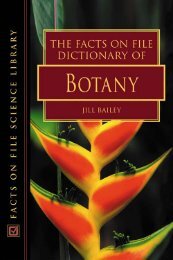Create successful ePaper yourself
Turn your PDF publications into a flip-book with our unique Google optimized e-Paper software.
3.36 TS of tbe young stem of Nerium<br />
oleander. Note the laric:ifers (arrows) which<br />
permeate the pith (1) and COrtex (2) and<br />
also occur in the X)-lem (3). (LM x 75.)<br />
I!<br />
Pith<br />
Conex<br />
Xylem<br />
3.37 TS of a young twig of the dicof)"<br />
ledon Tilia wrdata (lime) showing the<br />
secondary phloem. This is a complex tissue<br />
with wide flares of ray parenchyma cells (1)<br />
which divide tangentially to accommodate<br />
the increasing circumference of the stem as<br />
secondary thickening progresses. The<br />
conductive phloem elements (2) function<br />
ovcr several seasons and they arc interspersed<br />
with tangential bands of thick·<br />
walled fibres (3). Vascular cambium (4),<br />
secondary xylem (5). {LM x 70.)<br />
1 Ray parenchyma<br />
2 Phloem dements<br />
3 Fibres<br />
4 Vascular cambium<br />
5 Secondary xylem<br />
3.38 TS of the dicmyledon TWa cordata<br />
(lime) stem showing detail of the phloem<br />
(d., 3.37). The wide sie\'e tubes (1) (d.,<br />
3.37) are sandwiched between langenti:al<br />
bands of vcry thick·walled fibres (2). (L:M x<br />
285.)<br />
1 Sieve tubes<br />
2 Fibres<br />
73<br />
3.36<br />
3.37<br />
3.38





